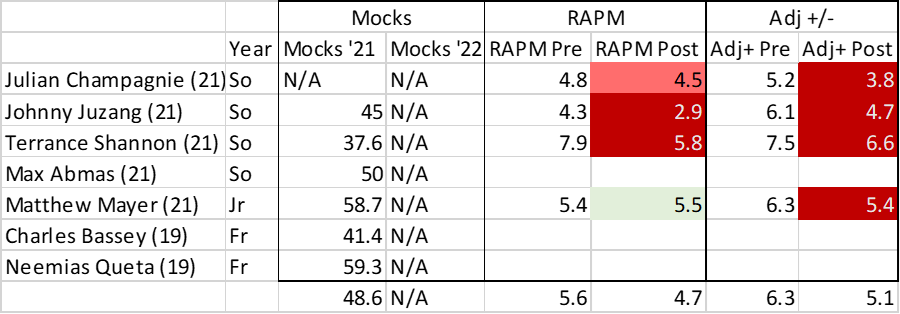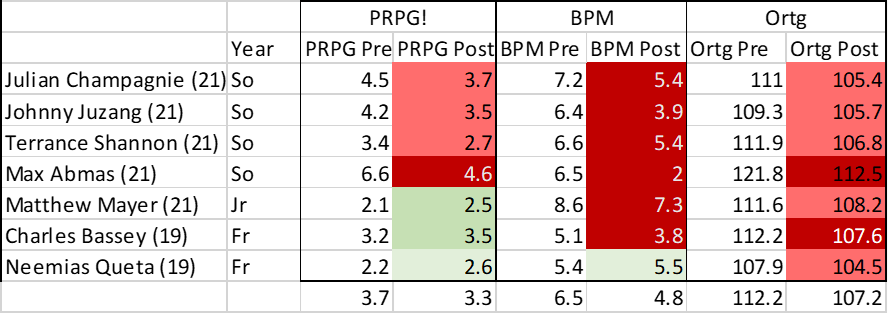
As a consensus top-50 NBA prospect, it wasn’t necessarily a shock that Justin Lewis was invited to attend the NBA Combine in Chicago later on May 18th, but it did give us a better idea that NBA personnel seem to agree with media members that Justin stands to be a legitimate draft prospect.
But while Justin should (and will) attend the combine to measure up against the best the draft will offer, it doesn’t necessarily mean the door back to Marquette and a third season of college ball is completely shut.
Of the 107 NBA Combine invitees in 2021 and 2019 with college eligibility remaining (skipping 2020 due to timing of the draft), 12 decided to return to college. Those 12 include some very prominent names, so I thought it would be helpful to gauge how each of those players performed the following season, and how it impacted their draft stock for this draft.
(Definitions and reasoning behind the criteria used can be found at the bottom of the post.)
Improved Stock: Ochai Agbaji, Isaiah Mobley, Quentin Grimes, Jordan Nwora, Devon Dotson
I’m sure we will hear the name Ochai Agbaji plenty in the next few weeks, as the go-to example of what can happen to your career by coming back to school. And for good reason, he is the ultimate example of what another year in NCAA play can provide.
He was off most mocks and big boards last year when he attended the combine, and after putting in a stellar season where he exploded in almost every facet in-route to a National Title and MOP trophy, he’s now a legitimate lottery prospect.

Devon Dotson had a similar rise in his season back, going from off most boards to a 2nd round draft valuation (though he would end up going undrafted). Jordan Nwora didn’t have quite the jump the 2 Kansas guards had, but did enough to end up as the 45th pick in the 2020 Draft.
Isaiah Mobley is still in the draft process, although he is at the fringes currently. Should he return, he would be following in Quentin Grimes’ footsteps, who stayed another year (at Houston) before ultimately becoming a 1st round draft pick in 2021.

On average, players that came back and improved their draft positioning saw 35%+ increases in plus/minus based stats, and 49%+ jumps in PRPG! And BPM. All of this is to say, there were across the board improvements, not just better shooting/scoring numbers.

Decreased Stock: Julian Champagnie, Johnny Juzang, Terrance Shannon, Max Abmas Matthew Mayer, Charles Bassey, Neemias Queta
And while 40% of those returning can say they made the “right” decision, that leaves us with the 60% that can be used as cautionary tales.

The 2021 returning class was particularly poor in the 2022 season, with 5 of the 7 having worse seasons and/or seeing their stock take a hit.
Marquette fans will be very familiar with both Julian Champagnie and Johnny Juzang, having played both the past 2 seasons, and seeing their shooting stars stall out a bit at the college level. Both saw significant dips in their offensive efficiency not explainable simply by carrying a bigger load while seeing regression in RAPM and Adj +/-. Neither is currently a top-60 consensus player in the upcoming draft.
Terrance Shannon and Matthew Mayer didn’t have quite the plunge of those 2, but didn’t see much (if any) growth in their advanced metrics that would put them in a better draft spot. Shannon will be returning to school for the 2023 season, while Mayer still hasn’t made his final decision.

The final 3 are mid-major players, which is a bit different from the 9 others we’ve discussed. The questions for them were about quality of opponents and having their games translate. Only Bassey was showing up in late 1st/early 2nd mocks, but he would end up coming back to school for 2 years before becoming the 53rd draft pick in the 2021 NBA draft.
Queta also came back for 2 seasons, having a much better Junior campaign and ultimately ending up as the 39th pick last season.
What most of these players do have in common, if you come back and don’t have a better year, you are most likely looking at a minimum of 2 seasons of school, not a simple 1 more and done.

Conclusions
It’s easy for me to parse numbers, but they will never tell the whole story. I don’t mean to advocate on Justin’s behalf for one decision over the other, I was simply curious at what we could expect should he decide to return to Marquette.
Frankly, coming back is no guarantee of an improvement to NCAA results or NBA perception. We only have a limited sample, but of that sample, more players have required another 2 years of school than have measurably improved their draft standing.
No matter what Justin chooses, in my opinion, there is no easy or clear answer from recent history.
Criteria
While it may be more difficult to interpret, I thought using an assortment of advanced metrics would give us the best results in accounting for change in role and additional usage.
Mocks: Where a consensus of The Athletic, ESPN and Chad Forde had these players being picked in mock drafts/big boards prior to the Combine.
RAPM: Short for regularized adjusted plus minus, it’s a method to incorporate Ridge Regression to adjusted plus minus. No, I don’t know how to explain it better, but encourage you to dig around hoop-explorer.com where you can see the results. Basically, 6 or higher is an all-conference high major player, 5-6 is a very good high major player, 4-5 is a starter level (and so on).
Adj +/-: Also from hoop-explorer, Adj +/- takes the basic on off data and adjusts it for strength of opponent, excluding garbage time stats from the equation.
PRPG!: This is Bart Torvik’s proprietary formula that measures how many points a given player is scoring over a replacement, adjusting for usage. Here is the full explanation: https://www.bigtengeeks.com/new-stat-porpagatu/
BPM: This is box plus minus as retrieved from barttorvik.com.
ORtg: Offensive efficiency per 100 possessions.


Leave a comment